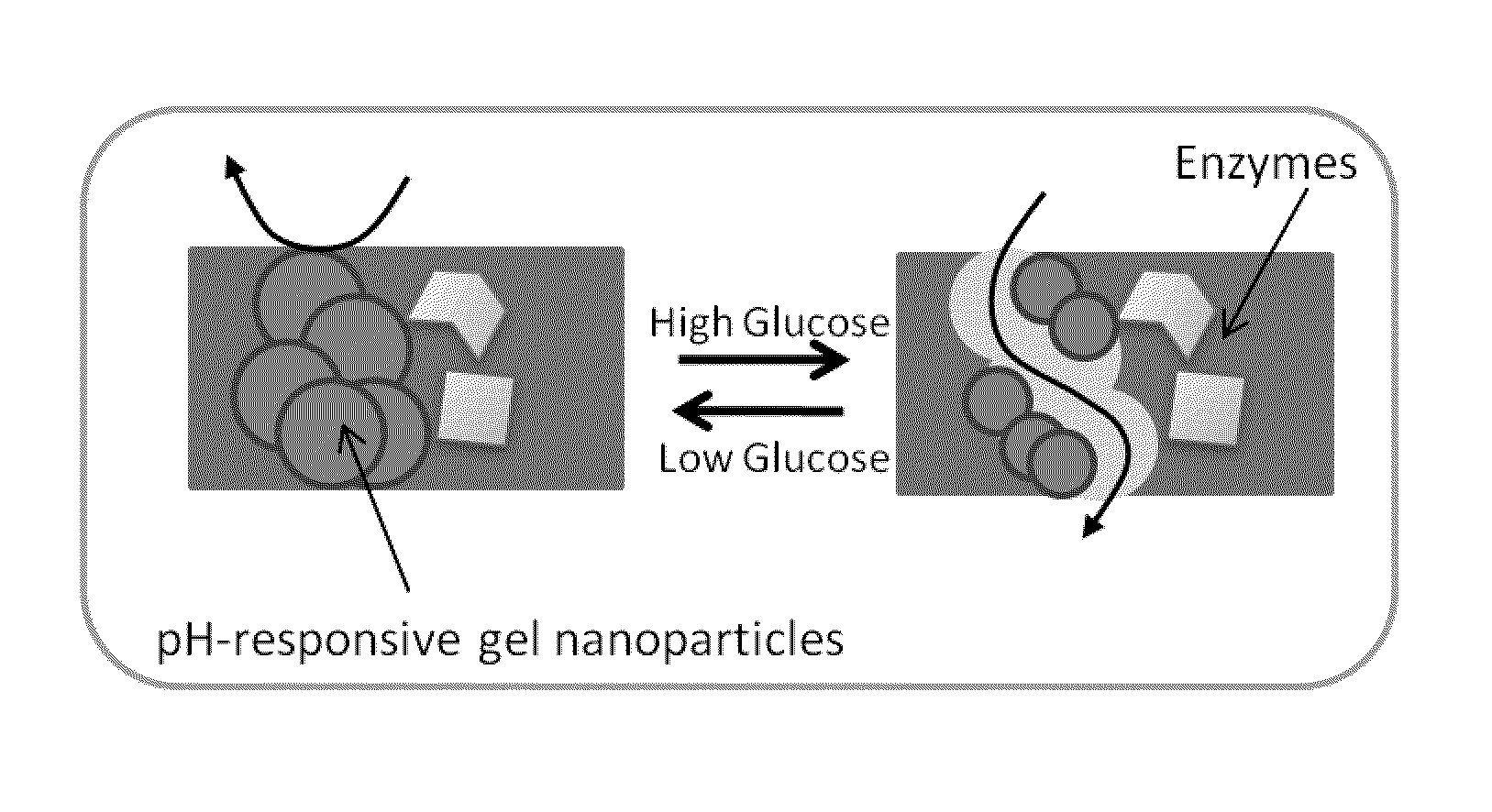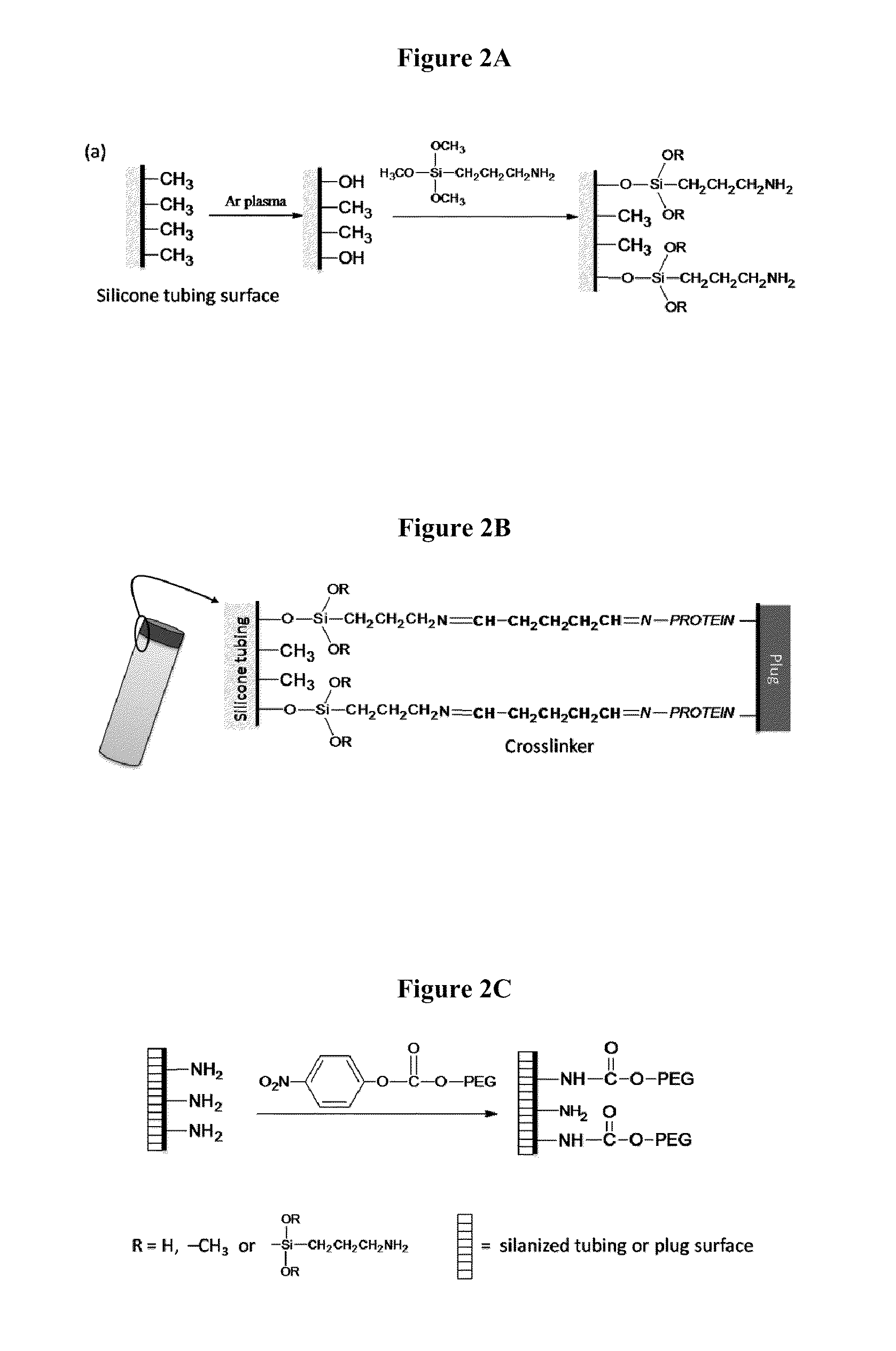Implantable-glucose responsive insulin delivery device
a technology of insulin delivery device and glucose, which is applied in the field of insulin delivery, can solve the problems of inability to monitor and deliver the insulin needed, pain in the process, inaccurate, etc., and achieve the effect of patients, and improving the safety of patients
- Summary
- Abstract
- Description
- Claims
- Application Information
AI Technical Summary
Benefits of technology
Problems solved by technology
Method used
Image
Examples
example 1
Synthesis of Hydrogel Nanoparticles
[0044]Poly(N-Isopropylacrylamide-co-methacrylic acid) (poly(NIPAM / MAA)) nanoparticles were synthesized by an aqueous dispersion polymerization process. NIPAM, MAA and N,N′-Methylene-bis-acrylamide (BIS), at a mole ratio of 1:1:0.068 were dissolved in DDI water giving a total concentration of 135 mM. Sodium dodecyl sulphate (SDS) at a concentration of 0.4 mM was added to stabilize the nanoparticles produced. The mixture was purged with N2 and then potassium persulfate (2.1 mM) was added to initiate the polymerization. The reaction was carried out at 70° C. under N2 atmosphere and stirring at 200 rpm for 4 h. The obtained nanoparticles were purified by membrane dialysis (molecular weight cutoff 12,000 to 14,000, Fisher Scientific) against DDI water. The diameter of the hydrogel nanoparticles was determined to be about 380±110 nm in pH PBS solution pH 7.4 (0.01M phosphate; 0.15M NaCl); 157±50 nm in PBS solution pH 5.0 (0.01M phosphate; 0.15M NaCl) and...
example 2
Synthesis and Characterization of MnO2 Nanoparticles
[0045]The sonochemical reduction of permanganate with manganese ions was used to prepare MnO2 nanoparticles (NPs). In brief, a potassium permanganate aqueous solution (5 mL, 0.05 mM) was kept under ultrasonic field for 30 s by using an ultrasonic processor probe operating at approximately 50 Hz (Heischer UP100H, Germany). Manganese acetate aqueous solution (1 mL, 0.07 mM) was added and the dark brown dispersion obtained was sonicated for an additional 30 s. Solid nanoparticles were isolated by ultracentrifugation, thoroughly washed with DDI water, and freeze-dried overnight. Prior to use, powdered MnO2 NPs were redispersed in DDI water or PBS solution (20-30 mg.mL−1) by ultrasonication (1 min / 50 HZ) followed by stirring overnight.
[0046]Characterization of MnO2 NPs was initially carried out from absorbance studies. The UV-Vis spectrum of the golden brown colloidal dispersion obtained is shown in FIG. 3. After the reaction with manga...
example 3
Preparation and Characterization of Glucose-Responsive Membranes
[0047]Membranes were prepared by crosslinking BSA with glutaraldehyde in the presence of 30 wt. % poly(NIPAM / MAA) NPs and various amounts of enzymes and MnO2 NPs as follows:
(i) membrane 1: 5 wt. % GOx; (ii) membrane 2: 5 wt. % GOx and 10 wt. % MnO2 NPs
[0048](iii) membrane 3: 5 wt. % GOx and 1.6 wt. % CAT (CAT / GOx=0.29 w / w) and (iv) membrane 4: 5 wt. % GOx, 1.6 wt. % CAT and 10 wt. % MnO2 NPs. In a typical preparation, to a small vial containing 6 mg of powder MnO2 NPs dispersed in 200 μL of pH 5.0 PBS solution, 28 mg of BSA, 3 mg of GOx and 0.86 mg of CAT were introduced and incubated at 37° C. for 10 min. Following the addition of 85 μL of a 200 mg.mL−1 dispersion of poly(NIPAM / MAA) NPs in DDI water, the mixture was stirred for 10 min, and then 15 μL of glutaraldehyde (grade I, 25%) was introduced. The mixture was quickly spread on a glass slide (˜3.5×2.0 cm) and allowed to cross-link at room temperature for 1 h. The o...
PUM
| Property | Measurement | Unit |
|---|---|---|
| concentration | aaaaa | aaaaa |
| concentration | aaaaa | aaaaa |
| concentration | aaaaa | aaaaa |
Abstract
Description
Claims
Application Information
 Login to View More
Login to View More - R&D
- Intellectual Property
- Life Sciences
- Materials
- Tech Scout
- Unparalleled Data Quality
- Higher Quality Content
- 60% Fewer Hallucinations
Browse by: Latest US Patents, China's latest patents, Technical Efficacy Thesaurus, Application Domain, Technology Topic, Popular Technical Reports.
© 2025 PatSnap. All rights reserved.Legal|Privacy policy|Modern Slavery Act Transparency Statement|Sitemap|About US| Contact US: help@patsnap.com



